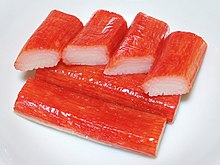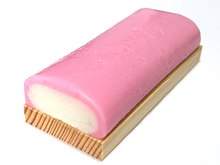Surimi
In China, the food is used to make fish balls (魚蛋/魚丸) and ingredients in a thick soup known as geng (羹), common in Fujian cuisine.
Alaska pollock, native to the seas around Japan, played an important role in the development of processed surimi due to its high protein biomass.
In 1969, Nishitani Yōsuke further discovered that the use of sucrose, or other carbohydrates such as sorbitol, acted as a cryoprotectant by stabilizing the actomyosin in the surimi without denaturing the fish protein the way salt does.
[1]: 6–7 When the Magnuson–Stevens Fishery Conservation and Management Act was enacted in 1976, the United States became involved in the surimi industry through joint ventures with Japanese fish processors.
Many newcomers to the surimi industry have emerged, including Lithuania, Vietnam, Chile, the Faroe Islands, France, and Malaysia.
According to the United States Department of Agriculture National Nutrient Database, fish surimi contains about 76% water, 15% protein, 6.85% carbohydrate, and 0.9% fat.
[5] Borax was once widely used in Asian fish balls to make the texture bouncier and to preserve the water content.


